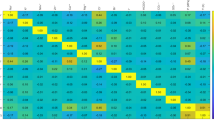Abstract
The meteorological early warning model of precipitation-induced landslides is a significant yet challenging task, due to the complexity and uncertainty of various influence factors. Generally, the existing machine learning methods have the drawbacks of poor learning ability and weak capability of feature extraction. Inspired by deep learning technology, we propose a deep belief network (DBN) approach with Softmax classifier and Dropout mechanism for meteorological early warning of precipitation-induced landslides to overcome these problems. With the powerful nonlinear mapping ability of DBN when training a large number of sample data, we use the greedy unsupervised learning algorithm of DBN to extract the intrinsic characteristics of landslide factors. Then, to further improve prediction accuracy of landslides, the Softmax classifier is added to the top layer of DBN neural network. Moreover, the Dropout mechanism is introduced in the training process to reduce the prediction error caused by the over-fitting phenomena. Taking Wenchuan earthquake affected area for example, after analysis of the factors influencing landslide disasters, the meteorological early warning model of landslides based on Dropout DBN-Softmax is established. Compared with the existing BP neural network algorithm and BP algorithm based on Particle Swarm Optimizer (PSO-BP) algorithm, the experimental results show that the new approach proposed has the advantages of higher accuracy and better technological performances than the former algorithms.






Similar content being viewed by others
References
Gao ZK, Jin ND (2012) A directed weighted complex network for characterizing chaotic dynamics from time series. Nonlin Anal Real World Appl 13(2):947–952
Alvioli M, Baum RL (2016) Parallelization of the TRIGRS model for rainfall-induced landslides using the message passing interface. Environ Modell Softw 81:122–135
Lee S, Ryu JH, Won JS, Park HJ (2004) Determination and application of the weights for landslide susceptibility mapping using an artificial neural network. Eng Geol 71(3/4):289–302
Pham BT, Pradhan B, Bui DT, Prakash I, Dholakia MB (2016) A comparative study of different machine learning methods for landslide susceptibility assessment: a case study of Uttarakhand area (India). Environ Modell Softw 84:240–250
Colkesen I, Sahin EK, Kavzoglu T (2016) Susceptibility mapping of shallow landslides using kernel-based Gaussian process, support vector machines and logistic regression. J Afr Earth Sci 118:53–64
Kornejady A, Ownegh M, Bahremand A (2017) Landslide susceptibility assessment using maximum entropy model with two different data sampling methods. Catena 152:144–162
Gerolymos N, Gazetas G (2007) A model for grain-crushing-induced landslides—application to Nikawa, Kobe 1995. Soil Dyn Earthq Eng 27(9):803–817
Chen YC, Chang KT, Chiu YJ, Lau SM, Lee HY (2013) Quantifying rainfall controls on catchment-scale landslide erosion in Taiwan. Earth Surf Process Landf 38(4):372–382
Akcali E, Arman H (2013) Landslide early warning system suggestion based on landslide—rainfall threshold: Trabzon Province. Teknik dergi 24(1):6307–6332
Chen XL, Liu CG, Yu L, Lin CX (2014) Critical acceleration as a criterion in seismic landslide susceptibility assessment. Geomorphology 217:15–22
Pistocchi A, Luzi L, Napolitano P (2002) The use of predictive modeling techniques for optimal exploitation of spatial databases: a case study in landslide hazard mapping with expert system-like methods. Environ Geol 41(7):765–775
Soowoong K, Bogun P, Bong SS, Seungjoon Y (2016) Deep belief network based statistical feature learning for fingerprint liveness detection. Pattern Recognit Lett 77:58–65
Guillermo LG, Lucas CU, Mónica GL, Pablo MG (2016) Deep learning for plant identification using vein morphological patterns. Comput Electron Agric 127:418–424
Geng J, Wang HY, Fan JC, Ma SR (2017) Deep supervised and contractive neural network for SAR image classification. IEEE Trans Geosci Remote Sens 55(4):2442–2459
Gao ZK, Cai Q, Yang YX, Dang WD, Zhang SS (2016) Multiscale limited penetrable horizontal visibility graph for analyzing nonlinear time series. Sci Rep 6:35622
Hinton GE, Deng L, Yu D, Dahl E, Mohsmed A, Jaitly N, Senior A, Vanhoucke V, Nguyen P, Sainath TN, Kingsbury B (2012) Deep neural networks for acoustic modeling in speech recognition: the shared views of four research groups. IEEE Signal Process Mag 29(6):82–97
Ronao CA, Cho SB (2016) Human activity recognition with smartphone sensors using deep learning neural networks. Expert Syst Appl 59:235–244
Gao ZK, Cai Q, Yang YX, Dong N, Zhang SS (2017) Visibility graph from adaptive optimal kernel time-frequency representation for classification of epileptiform EEG. Int J Neural Syst 27(4):1750005
Shim H, Lee S (2015) Multi-channel electromyography pattern classification using deep belief networks for enhanced user experience. J Central South Univ 22(5):1801–1808
Papa JP, Scheirer W, Cox DD (2016) Fine-tuning deep belief networks using harmony search. Appl Soft Comput 46:875–885
Hinton GE, Osindero S, Teh YW (2006) A fast learning algorithm for deep belief nets. Neural Computat 18(7):1527–1554
Shen FR, Chao J, Zhao JX (2015) Forecasting exchange rate using deep belief networks and conjugate gradient method. Neurocomputing 167:243–253
Wu HB, Gu XD (2015) Towards dropout training for convolutional neural networks. Neural Netw 71:1–10
Acknowledgements
The research was supported by the Project in 2014 by National Natural Science Foundation of China (Authorized Number: 41401449) and the University science and technology Project (No. J16LH05).
Author information
Authors and Affiliations
Corresponding author
Rights and permissions
About this article
Cite this article
Huang, L., Xiang, Ly. Method for Meteorological Early Warning of Precipitation-Induced Landslides Based on Deep Neural Network. Neural Process Lett 48, 1243–1260 (2018). https://doi.org/10.1007/s11063-017-9778-0
Published:
Issue Date:
DOI: https://doi.org/10.1007/s11063-017-9778-0




